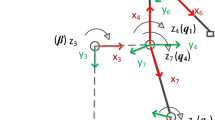Abstract
This paper presents a multiobjective optimization (MOO) approach to predicting dynamic lifting for a three-dimensional, highly redundant digital human model with 55 degrees of freedom. The optimization problem is formulated to optimize two objective functions simultaneously—dynamic effort and stability—subject to basic physical and kinematical constraints. The predictive dynamics approach is used to solve for the joint angles, torque profiles, and ground reaction forces. The weighted sum approach of MOO is used to aggregate the two objective functions, and the Pareto optimal set for the problem is generated by systematically varying the weighting parameters for the objective functions. Experimental data are used to validate the final simulation. Several examples are presented to demonstrate the effect of the weighting parameters for the two objective functions on the predicted box-lifting strategies. The results show that the proposed MOO approach improves the simulation results compared to the single objective optimization formulation. Also, the formulation is less sensitive to the weighting coefficient for the stability criterion.
Similar content being viewed by others
References
Chaffin, D.B., Anderson, D.B.J.: Occupational Biomechanics. Wiley, New York (1991)
Huang, C., Sheth, P.N., Granata, K.P.: Multibody dynamics integrated with muscle models and space-time constraints for optimization of lifting movements. In: ASME International Design Engineering Technical Conferences. Long Beach, CA, ASME Paper No. DETC2005-85385 (2005)
Dysart, M.J., Woldstad, J.C.: Posture prediction for static sagittal-plane lifting. J. Biomech. 29(10), 1393–1397 (1996)
Zhang, X., Nussbaum, M.A., Chaffin, D.B.: Back lift versus leg lift: an index and visualization of dynamic lifting strategies. J. Biomech. 33(6), 777–782 (2000)
Arisumi, H., Chardonnet, J.R., Kheddar, A., Yokoi, K.: Dynamic lifting motion of humanoid robots. In: 2007 IEEE International Conference on Robotics and Automation, Roma, Italy, pp. 2661–2667 (2007)
Schiehlen, W.: Multibody system dynamics: roots and perspectives. Multibody Syst. Dyn. 1, 149–188 (1997)
Leboeuf, F., Bessonnet, G., Seguin, P., Lacouture, P.: Energetic versus sthenic optimality criteria for gymnastic movement synthesis. Multibody Syst. Dyn. 16, 213–236 (2006)
Bottasso, C.L., Prilutsky, B.I., Croce, A., Imberti, E., Sartirana, S.: A numerical procedure for inferring from experimental data the optimization cost functions using a multibody model of the neuro-musculoskeletal system. Multibody Syst. Dyn. 16, 123–154 (2006)
Xiang, Y., Chung, H.J., Kim, J.H., Bhatt, R., Rahmatalla, S., Yang, J., Marler, T., Arora, J.S., Abdel-Malek, K.: Predictive dynamics: an optimization-based novel approach for human motion simulation. Struct. Multidiscip. Optim. (2009). doi:10.1007/s00158-009-0423-z
Xiang, Y., Arora, J.S., Rahmatalla, S., Abdel-Malek, K.: Optimization-based dynamic human walking prediction: one step formulation. Int. J. Numer. Methods Eng. 79(6), 667–695 (2009)
Denavit, J., Hartenberg, R.S.: A kinematic notation for lower-pair mechanisms based on matrices. Trans. ASME J. Appl. Mech. 215–221 (1955)
Cheng, H., Obergefell, L., Rizer, A.: Generator of body (GEBOD) Manual, AL/CF-TR-1994-0051. Armstrong Laboratory, Wright-Patterson Air Force Base, OH (1994)
Toogood, R.W.: Efficient robot inverse and direct dynamics algorithms using micro-computer based symbolic generation. In: IEEE International Conference on Robotics and Automation, Scottsdale, AZ, pp. 1827–1832 (1989)
Xiang, Y., Arora, J.S., Abdel-Malek, K.: Optimization-based motion prediction of mechanical systems: sensitivity analysis. Struct. Multidiscip. Optim. 37(6), 595–608 (2009)
Vukobratović, M., Borovac, B.: Zero-moment point—thirty five years of its life. Int. J. Humanoid Robot. 1(1), 157–173 (2004)
Marler, R.T., Arora, J.S.: Function-transformation methods for multi-objective optimization. Eng. Optim. 37(6), 551–570 (2005)
Gill, P.E., Murray, W., Saunders, M.A.: SNOPT: An SQP algorithm for large-scale constrained optimization. SIAM J. Optim. 12(4), 979–1006 (2002)
Lee, S.H., Kim, J., Park, F.C., Kim, M., Bobrow, J.E.: Newton-type algorithm for dynamics-based robot movement optimization. IEEE Trans. Robot. 21(4), 657–667 (2005)
Authier, M., Lortie, M., Gagnon, M.: Manual handling techniques: Comparing novices and experts. Int. J. Ind. Ergon. 17(5), 419–429 (1996)
Author information
Authors and Affiliations
Corresponding author
Rights and permissions
About this article
Cite this article
Xiang, Y., Arora, J.S., Rahmatalla, S. et al. Human lifting simulation using a multi-objective optimization approach. Multibody Syst Dyn 23, 431–451 (2010). https://doi.org/10.1007/s11044-009-9186-y
Received:
Accepted:
Published:
Issue Date:
DOI: https://doi.org/10.1007/s11044-009-9186-y




